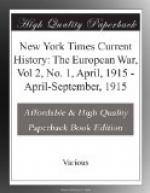(ii) To the General
Officer commanding the Fourth Brigade
(Lord Cavan) for the
thorough manner in which he carried out
the orders of the General
Officer commanding the division.
(iii) To the regimental officers, non-commissioned officers, and men of the Second Coldstream Guards and Irish Guards, who, with indomitable pluck, stormed two sets of barricades, captured three German trenches, two machine guns, and killed or made prisoners many of the enemy.
8. During the period under report the Royal Flying Corps has again performed splendid service.
Although the weather was almost uniformly bad and the machines suffered from constant exposure, there have been only thirteen days on which no actual reconnoissance has been effected. Approximately, 100,000 miles have been flown.
In addition to the daily and constant work of reconnoissance and co-operation with the artillery, a number of aerial combats have been fought, raids carried out, detrainments harassed, parks and petrol depots bombed, &c.
Various successful bomb-dropping raids have been carried out, usually against the enemy’s aircraft material. The principle of attacking hostile aircraft whenever and wherever seen (unless highly important information is being delivered) has been adhered to, and has resulted in the moral fact that enemy machines invariably beat immediate retreat when chased.
Five German aeroplanes are known to have been brought to the ground, and it would appear probable that others, though they have managed to reach their own lines, have done so in a considerably damaged condition.
9. In my dispatch of Nov. 20, 1914, I referred to the reinforcements of territorial troops which I had received, and I mentioned several units which had already been employed in the fighting line.
In the positions which I held for some years before the outbreak of this war I was brought into close contact with the territorial force, and I found every reason to hope and believe that, when the hour of trial arrived, they would justify every hope and trust which was placed in them.
The Lords Lieutenant of Counties and the associations which worked under them bestowed a vast amount of labor and energy on the organization of the territorial force; and I trust it may be some recompense to them to know that I, and the principal commanders serving under me, consider that the territorial force has far more than justified the most sanguine hopes that any of us ventured to entertain of their value and use in the field. Commanders of cavalry divisions are unstinted in their praise of the manner in which the yeomanry regiments attached to their brigades have done their duty, both in and out of action. The service of divisional cavalry is now almost entirely performed by yeomanry, and divisional commanders report that they are very efficient.
Army corps commanders are loud in their praise of the territorial battalions, which form part of nearly all the brigades at the front in the first line, and more than one of them have told me that these battalions are fast approaching—if they have not already reached—the standard of efficiency of regular infantry.




